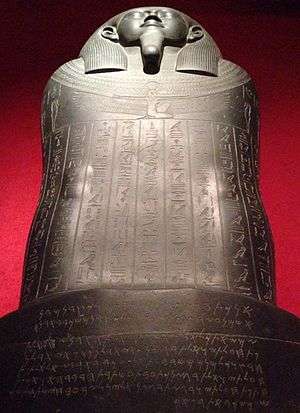Tabnit
Tabnit was the Phoenician king of Sidon circa 490 BCE,[1] He was the father of King Eshmunazar II.
Tabnit | |
|---|---|
 The Tabnit sarcophagus. | |
| Allegiance | Achaemenid Empire |
| Years of service | Circa 490 BC |
| Rank | King of Sidon |

He is well known from his sarcophagus, decorated with two separate and unrelated inscriptions – one in Egyptian hieroglyphics and one in Phoenician script. It was created in the early 5th century BC, and was unearthed in 1887 by Osman Hamdi Bey at the Ayaa Necropolis near Sidon together with the Alexander Sarcophagus and other related sarcophagi. Tabnit's body was found floating perfectly preserved in the original embalming fluid.[2] Both the sarcophagus and Tabnit's decomposed skeleton are now in the Istanbul Archaeology Museums.[3]
The sarcophagus, together with the Eshmunazar II sarcophagus, were possibly acquired by the Sidonians following their participation in the Battle of Pelusium (525 BC),[4] and served as models for later Phoenician sarcophagi.[5]
Dating
Both the Tabnit sarcophagus and the Eshmunazar II sarcophagus are thought to originally date from the Twenty-sixth Dynasty of Egypt, which had its capital at Sais.[5] This is partially due to their resemblance to similar sarcophagi such as the Psamtik II-era Horkhebit sarcophagus from Saqqara, now in the Metropolitan Museum of Art.
Notes
- "Middle East Kingdoms Ancient Central Levant States - Sidon". Kessler Associates. Retrieved 23 May 2017.
- Gubel, Eric (2003), "Phönizische Anthropoide Sarkophage by Katja Lembke", Bulletin of the American Schools of Oriental Research, 332: 98–100, JSTOR 1357812
- İstanbul Archaeological Museums
- Nitschke 2007, p. 71: "Three of these Egyptian sarcophagi manufactured during the twenty-sixth dynasty were apparently acquired by the Sidonians, perhaps as a result of Phoenician participation in Cambyses’ conquest of Egypt in 525 B.C."
- Nitschke 2007, p. 72.
References
| Wikimedia Commons has media related to Tabnit. |
- Hamdi Bey, Osman; Reinach, Théodore (1892), Une nécropole royale à Sidon [A royal necropolis in Sidon] (in French) (editio princeps)
- Hamdi Bey, Osman; Reinach, Théodore (1892), Une nécropole royale à Sidon: fouilles: Planches [A royal necropolis in Sidon: excavations] (in French) (Plates)
- Jessup, Henry Harris (1910), Fifty-Three Years In Syria, 2, Fleming H. Revell Company, p. 507
- Gottheil, Richard (1889), "The Inscription of Tabnit", Hebraica, 5 (2): 197, doi:10.1086/369051, JSTOR 527253
- Bommas, Martin (2006), "Die hieroglyphischen Texte auf dem Sarg des Tabnit" [The hieroglyphic texts on the Sarcophagi of Tabnit], Orientalia, 75 (1): 15
- Assmann, Jan, "Zur Baugeschichte der Königsgruft von Sidon" [The construction history of the royal tomb of Sidon] (PDF), Archäologischer Anzeiger: 690–716
- Nitschke, Jessica (2007), Perceptions of Culture:Interpreting Greco-Near Eastern Hybridity in the Phoenician Homeland (Ph.D.), University of California, BerkeleyCS1 maint: ref=harv (link)
- Torrey, Charles (1902), "A Phoenician Royal Inscription", Journal of the American Oriental Society, 23: 156–173, JSTOR 592387